Basketball Defense - the Pack Line Defense
By Dr. James Gels, From the Coach’s Clipboard Basketball Playbook"Helping coaches coach better..."
Disclosure: This page contains affiliate links, which means that Coach's Clipboard receives a small commission (at no cost to you) if you make a purchase using these links.

The pack-line defense is a variation of man-to-man defense developed by Dick Bennett at Washington State University. Something similar has been used Sean Miller, Tony Bennett, Chris Mack and others.
First understand pressure man-to-man defense. I used to say that there is probably no reason to use the pack line defense if you have excellent, quick athletes who are good defenders. Just use standard pressure man-to-man defense. On the other hand, the pack line defense will help less talented teams compete with better teams, and will also help prevent point guard dribble-penetration.
Since many teams nowadays use the dribble-drive to attack, it makes good sense to use the packline defense no matter what your team's skill level is. The packline will help clog those seams and stop the dribble-drive. The packline is a gap defense, that still puts pressure on the ball. The packline defense also puts your players in better position for defensive rebounding, and may result in less fouling.
The "pack line"
The pack line man-to-man defense is a "sagging" man-to-man defense. The idea is to clog the inside, protect the paint, and prevent dribble-penetration. Instead of defenders (whose man is one pass away) playing on the line in denial, they sag back inside the imaginary "pack line". The pack line is an imaginary line two feet inside the 3-point arc (see diagram A). The four defenders off the ball are positioned inside that line.
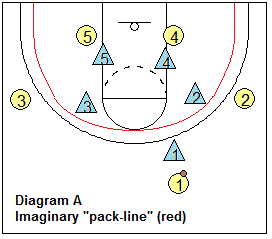
One defender pressures the ball, while the other four defenders are inside the pack line, hedging in the gaps. This allows the pass on the perimeter, but closes down the gaps and prevents dribble-penetration. The prime goal, as in any defense, is to stop the ball.
Pressure the ball
When the ball is on the perimeter, the on-ball defender applies tight, harassing pressure. He/she must stop the ball, make the ball-handler uncomfortable, and make it difficult for the ball-handler to see the floor. The on-ball defender contains and pressures the ball, but if he/she is beaten, the pack line gapping defenders are there to give help and stop the ball. So the on-ball defender can feel confident and trust that his teammates will be there to help, even if the opponent is quicker.
Stopping the gaps
It's pretty hard to do all three things... deny, help and recover. In the pack line defense, gapping defenders only have to help and recover, and it is easier because the defender is already in position to give help. Gapping defenders are inside the pack line in a "ball-you-man" position, and reposition themselves as the ball and the offensive players move. The one instance when all players go into complete deny is when there is a dead ball situation (the ball-handler has stopped the dribble). Everyone yells, "dead, dead, dead" and denies the next pass, looking for the 5-second call.
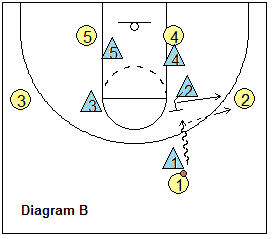
Notice in diagram B above that X1 is pressuring the ball, while the remaining four defenders are inside the pack line. As O1 attempts to dribble-penetrate, the X2 defender is already in position to help stop the dribble. When the pass goes back out to O2, or O1 picks up his/her dribble, X2 immediately recovers to his own man O2.
In stopping the seams (gaps), X2 fakes a trap on the ball just to stop the dribble, but instead of actually trapping, once the ball is stopped, immediately recovers to his man (assuming the pass goes there). Importantly, a gapping defender should always be able to see his own man. Otherwise, his man could back-cut or flare-cut uncontested.
Close-out with "high hands"
In diagram C above, the ball is passed to O3. O1 immediately "jumps to the ball" and drops back inside the pack line. X3 quickly closes-out with high hands and applies pressure on the ball (O3).
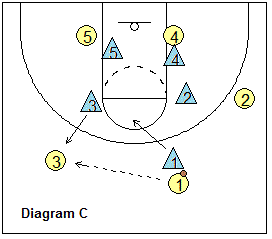
Defenders should close-out with hands high in order to contest the outside shot, and then assume the usual defensive stance when the ball is put on the floor, or the initial shot is stopped. The offensive player may attempt to dribble around the closing defender, but we have the seams stopped with our other four defenders. When closing out, this does not mean "flying" out or leaping at the ball. The defender must keep his feet on the floor and contain the ball. Once the defender has closed-out, he/she maintains good pressure on the ball.
Deny baseline
Another thing that is different from standard pressure man-to-man defense is that in the pack line defense, the ball is not forced to the baseline, but rather the baseline is denied. The ball is not actually forced to the middle, it's just that the baseline is denied. In diagram D, X2 overplays to prevent the ball from being dribbled baseline. If O2 dribbles into the top gap, X1 will help stop the seam. As the ball is passed out to O1, X1 closes-out with high hands.
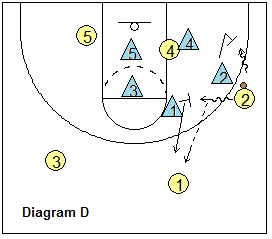

Post defense
In defending the low post, defenders full-front when the ball is at the top (diagram C), or in the corner (diagram E). When the ball is on the wing (diagram D), a 3/4 front from the top side is used by many coaches. This works with this defense because the wing defenders deny the baseline.
If the ball does get into the post, you must decide whether you are going to defend this with your post defender sliding between the ball and the basket and playing 1-on-1, or whether you want to double-team with either the opposite post player, or a perimeter player. This may depend on your opponent... a strong post player, double-team the post. A weak post player and good outside shooters, play the post 1-on-1.
Some coaches prefer to "choke the post" with the ballside wing perimeter defender dropping inside and clogging the post (when the ball enters the post from the wing). When the ball is passed back out to the wing, that wing defender sprints back out and closes-out with high hands.
Remember that denying and defending the low post has more to do with hard work, aggressiveness, determination, and being tough than technique.
In defending the high post, try to deny that pass by 1/2-fronting. The defender must be careful however, not to get pinned outside and get beaten by the lob pass. Notice in diagram F that the pack line defense tends to clog the high post fairly well due to the position of the gapping wing defenders.
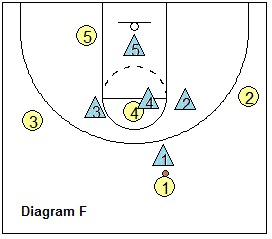
Pick and roll screens
The pick and roll is fairly well-defended, as the paint area is clogged with defenders. In diagram G, there is a pick and roll on the wing. Diagrams H and I show a pick and roll with the high post player stepping out to screen and roll. X4 "shows" over the top of the screen to stop the ball and then recovers back to O4. Notice that X3 is in a position to help X4 in stopping O4 cutting inside off the screen. X3 then has to be able to recover to O3 if the pass goes there. Optionally, X2 (instead of X3) could give the initial help on O4 until X4 recovers. As with any defense, communication is key in dealing with screens.
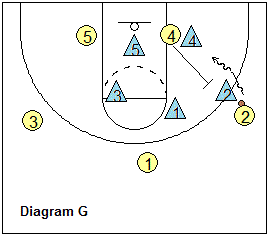
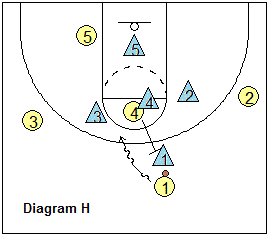

In summary, the pack line defense not only helps a less-athletic team compete with a stronger, quicker team, but also helps good athletic teams in stopping the dribble-drive. You can use your full-court press, but then drop back into the half-court pack line defense.
There are some disadvantages. If you are playing without a shot clock, the offense can take as much time as they want, and dictate a slower tempo. With the shot clock rule, as the offense gets deeper into the shot clock, there is more urgency to shoot, and the pack line defense is more effective here.
Also, if you are behind late in the game, the offense can "run the clock", unless you come out and start denying passes. So the pack line defense is a problem here. Now you are caught in a situation of having to play deny defense with more pressure on the outside, and this is often difficult to do when you are not used to playing that way. It is usually easier for a typical pressure-deny man-to-man defense to drop back and play the pack line defense, than vice-versa.
Some teams might want to use both... man-to-man pressure defense (call it "Red"), and the pack line defense (call it "Blue"). Using the pack line defense can help a good man-to-man team that is having difficulty stopping point guard dribble-penetration.
From Matt Woodley's Pack Line Defense 2-Pack
From Matt Woodley: Pack Line Modifications to Stop the Pick-and-Roll
Related pages: